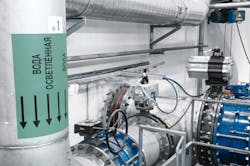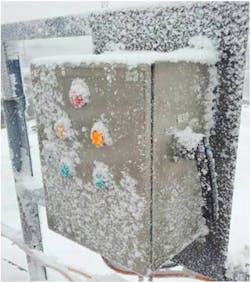Covered by multiple public utilities known as vodokanals, Russia's water sector has not got the best reputation for efficient and modern service. Yet St Petersburg managed to save €65,000 by upgrading a drinking water plant with pneumatic automation technology. A look at whether such success could be recreated elsewhere in the country.
By Tom Freyberg
The water sector may be about controlling and distributing a liquid that flows, yet investment into Russia's water sector could be called anything but flowing. Water distribution has a reputation of being poorly managed and unequally distributed across the vast country.
One possible reason for a lack of privatisation is that 4,000 separate operators – mostly owned by municipal authorities – are responsible for drinking water and wastewater across the country.
Water supply and wastewater treatment in Russia is managed by "Vodokanals". The progressive decentralisation process of water set out to bring the decision-making process closer to local conditions. In reality, it created difficult conditions as a result of a sudden disintegration of Ministries of Communal Services and an over-fragmentation of the sector. Currently 84% of Vodokanals are operated by largely ineffective and commercially unviable municipal enterprises.
Yet it is a country that is abundant with this natural resource: almost a quarter of global water resources are located within Russia. The challenge lies in getting high quality water resources from mountain regions, the Baikal Lake and rivers in Eastern Siberia, to the more populated regions.
Even the Russian Water Association is first to admit the technology challenges facing its nation: "The existing water supply system in Russia uses obsolete Soviet times technology. The key assets are exhausted, and go out faster and faster. Investments and implementation of new technologies for the system re-equipment may not catch up with the obsolescence and breakdown of the key assets."
To summarise this quote into key statistics, over 40% of the water supply network is in urgent need of refurbishment and modernisation.
Putin's pike and investment spike
Estimates from industry analysts Frost & Sullivan suggest that $11 billion is required for the necessary upgrades.
The Pure Water Federal Target Programme for 2011-2017, signed in December 2010, aims to increase coverage of water and wastewater services in Russian regions.
Aims include reaching 95% for safe water supply coverage and 84% of wastewater collection and treatment in 2017.
Russian President Vladimir Putin may be associated more with the topic of water from another macho PR stunt involving being photographed with a caught fish (opponents have questioned the alleged weight), yet he has also made headlines for comments on privatization.
At the end of July GWI reported that president Putin would sell off under performing water utilities into the private sector by 2016. Vodokanals would be assessed based on quality of facilities, as well as water loss.
The latter is one serious issue in Russia: high water losses account for almost 50% of overall water supply.
The plans would see poor performing utilities offered to the private sector as concessions on a competitive tender basis.
St Petersburg to lead the next [water] revolution?
St Petersburg has set standards in architecture and city planning, right from the time of its foundation over 300 years ago. Now this city, the former capital of Russia, is playing a leading role in the field of drinking water treatment.
The most northerly city in the world with a population of more than a million has resolved to implement a programme to increase the energy efficiency of the drinking water supply for its southern areas.
For this purpose St. Petersburg has invested 2.6 billion roubles (around $78 million) over a period of three years.
In addition to the modernisation of 34 pumping stations, St. Petersburg's Vodokanal has set itself the target of reducing the electricity consumption of the drinking water supply system by more than a third.
As the Vodokanal supplies 4.8 million people with 1.9 million cubic metres of drinking water every day, a third of total energy costs is a substantial amount.
"This is not only a regulation driver, but also it's their task that the city of St Petersburg identified as their own political interest to show that it's possible," Armin Müller, segment manager for water at German technology supplier Festo tells WWi magazine.
"St Petersburg also has the status of being a pilot city and also in competition to Moscow. In terms of governance they want to prove that they're able to decrease the energy consumption by a third to improve the quality for water and wastewater services."
Being the 'pilot city' of Russia has also meant St Petersburg has been using ultraviolet treatment technology for the bulk of the city's water treatment. Other Russian cities are expected to follow.
Modernising drinking water supply
Previously, electric drives were the first choice for Russia's water treatment plants, for processes like the opening and closing of inlets and outlets for sand-bed filters or in pumping stations.
"In order to achieve the energy-saving targets which we had set ourselves, we therefore needed to find new solutions," explains Maksim Pirschin, manager of the new block K-6 of the Surface Water Treatment Plant South in St. Petersburg.
Block K-6 of the waterworks alone provides 350,000 m³ of drinking water, through 20 new sand-bed filters. Each filter basin is assigned six butterfly valves with actuators and shut-off valves to open and close the inlets and outlets. Using electrical drives would have meant an installed load of 75 kW, according to Festo, with the plant not being able to supply this without extending the electrical infrastructure.
Instead, a solution involving a pneumatic system with actuators DAPS, including two air compressors, was suggested, which required an installed load of only 10 kW.
In addition to valve assemblies consisting of butterfly valves with actuators, shut-off valves and sensor boxes; Vodokanal opted for ready-to-install control cabinets with VTSA valve terminals, pressure and flow sensors and service units from Festo's MS series.
The control system gathers current data and compares this continuously with defined set points. The supplied automation technology is fully integrated into this monitoring process and uses sensor signals to supply up-to-date information on the operating status of individual plant sections.
"Simply by replacing the electric drives with 120 pneumatic actuators, we were able to save at least an additional €65,000," adds Pirschin.
Modernising Moscow
With St Petersburg demonstrating financial and energy savings from water technology upgrades, has it spurred on its Russian bigger brother and capital city, Moscow?
It appears so. In June the Bank of Moscow announced it would be assisting water and wastewater company, Gorvodokanal Volgograda, with 300 million RUR ($9.1 million) loan for a water metering programme for residential properties.
Despite such cash injections, low tariffs continue to hinder sector development.
Mosvodokanal (MVK), the city's water supplier to 13 million consumers and the largest in Russia, reportedly faces financial trouble. It is not helped by the large financial gap between water production costs and how much consumers pay for the service. The city government wishes to keep water tariffs low, as the social gaps widens and even a small increase could severely affect many citizens affected by poverty. To put this into context: tariffs in Moscow are said to be among the lowest in Eastern Europe.
As reported in the Moscow Times, MVK is also affected by general investor prejudice that the industry suffers from a lack of transparency and corruption.
Festo's Müller confirms the problem not just in Russia, but the region as a whole.
"Strategically Eastern Europe is a very interesting market, especially the new countries joining the EU," he says.
"We also know that they have major funding problems but they also have major corruption problems. So, we have to drop ourselves back from being part of this. At Festo this is completely a no go. This is also the concern we have to reach our plans/targets, as in some countries this is the way to make business in municipal areas, such as water and energy."
Taking a strong stance against corruption, Müller reveals that Festo plans to bid for Moscow's drinking water modernisation tender. This follows meetings at the Metropolitan Solutions Show in Hannover.
Eastern European opportunities
The segment manager for water believes opportunities remain outside of the municipal market too.
"Strategically Russia is the biggest market, as well as Poland, Czech Republic and Hungary," he says. "One other issue that we are focusing on more and more is having the municipal side but also more industrial applications."
Müller says that when he first started at Festo six years ago, the overall global investment into water was broken down as 90% into municipal and 10% industrial. Now it's as much as 40% going towards industrial.
Water supply across Russia is in desperate need of modernisation. The St Petersburg project is one example that shows, once lengthy contract negotiation has been passed, private sector technology and solutions can make a difference. A saving of €65,000 is notable for any utility.
With the 2017 target for the Pure Water Federal Target Programme quickly approaching, the country has a long way to go in a short space of time, if it is to meet its water and wastewater targets.
This article was written by Tom Freyberg. For more information email: [email protected]






